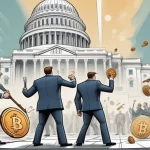Trump’s Crypto Empire Grows Amid Regulatory Delays and Ethical Concerns

Trump’s Crypto Gambit: Legislation Lags as Family Ventures Surge
President Donald Trump is doubling down on cryptocurrency, urging Congress to fast-track stablecoin and market structure bills while his family’s ventures—World Liberty Financial (WLF), American Bitcoin Corp (ABTC), and more—rake in millions. This collision of political power and personal profit is a powder keg, promising both groundbreaking innovation and glaring conflicts of interest in the race to define the future of decentralized finance.
- Legislative Gridlock: Senate passes GENIUS stablecoin bill, House stalls on STABLE; market structure deadlines loom.
- Trump’s Empire: Family’s 40% stake in WLF fuels $550 million in token sales; USD1 stablecoin posts dubious $3.37 billion volume.
- Ethical Quagmire: Democrats cry foul over conflicts, GOP blocks oversight; transparency takes a backseat.
Congress Crawls While Crypto Booms
The U.S. is at a critical juncture for cryptocurrency regulation, with lawmakers scrambling to catch up to an industry that’s been running laps around them for years. The Senate took a big step forward on June 17, 2025, passing the GENIUS stablecoin bill with a bipartisan 68-30 vote. This legislation, as unpacked by legal experts, classifies payment stablecoins—digital tokens pegged to fiat like the dollar for price stability—as neither securities nor commodities. It demands 1:1 backing with high-quality liquid assets (think U.S. Treasuries, unlikely to tank in value) and puts big issuers with over $10 billion in circulation under Federal Reserve or OCC scrutiny to prevent fraud and ensure stability akin to traditional banks. Smaller players can operate under state rules if they align with federal standards. It’s a potential game-changer, offering a clear rulebook for stablecoins to thrive without the Wild West chaos we’ve seen in the past. For more on the timeline and details, check the latest updates on U.S. crypto legislation for 2023 Senate GENIUS and House CLARITY bills.
But don’t pop the champagne yet. The House is lagging on its own STABLE bill (formally the Stablecoin Transparency and Accountability for a Better Ledger Economy Act of 2025), debating whether to rubber-stamp the Senate’s version or drag things out with reconciliation. Meanwhile, on broader market structure laws—think regulations for crypto exchanges and trading platforms—the House has pushed its CLARITY bill through committees, but the Senate is still doodling principles, aiming for a draft by August and a final version by September 30. Senator Tim Scott, chair of the Senate Banking Committee, stressed the crunch, saying:
“There is a timeline for market structure to be completed by September 30.”
Bo Hines, executive director of the Presidential Council of Advisers for Digital Assets, echoed the urgency with a hard line:
“We are committed to getting market structure done by the end of September. Period.”
Yet Senator Cynthia Lummis threw cold water on the hype, suggesting we might not see passage until year-end, far from Trump’s rosy July 4 signing fantasy. If history’s any guide, look at the 2021 Infrastructure Bill debates—crypto regulation has a knack for stalling. So, while lawmakers bicker over fine print, the industry keeps sprinting. Will they catch up before the next big scam or crash? That’s the billion-dollar question. For deeper insights into ongoing legislative efforts, see this analysis on stablecoin legislation updates for 2025.
Trump’s Crypto Cash Cow: WLF and USD1 Under the Microscope
While Congress drags its feet, Trump’s family is building a crypto empire that could rewrite the rules before they’re even inked. Holding a 40% stake in World Liberty Financial (WLF), a decentralized finance (DeFi) project, the Trumps are knee-deep in a sector aiming to cut out middlemen like banks using blockchain tech for direct, autonomous financial systems. WLF has hauled in over $550 million in sales of its WLFI governance token, including a $100 million chunk to the UAE-based Aqua1 Foundation. Add in high-profile advisors like Justin Sun, founder of TRON blockchain, who snapped up $75 million in tokens, and you’ve got a global feeding frenzy. But whispers of reciprocal token buys and shady pitches—think secret multimillion-dollar payments for endorsements, dubbed “unethical” by industry execs—cast a long shadow. Community discussions around WLF transparency issues highlight growing unease. Is this innovation or just a well-connected grift?
Then there’s WLF’s USD1 stablecoin, posting numbers that defy logic. With a market cap of $2.2 billion, it logged a 24-hour trading volume of $3.37 billion, outpacing Circle’s USDC, a veteran in the space. For comparison, it’s like a corner store out-selling Walmart in a day—possible, but suspiciously staggering. In a stablecoin market now worth $251.7 billion (up 22% in 2025), explosive growth isn’t unheard of, but USD1’s volume-to-cap ratio screams potential wash trading—artificial trades to inflate numbers—or other market tricks. A closer look at the authenticity of USD1’s trading volume compared to USDC raises red flags. A Crowe LLP report confirms BitGo holds $2.1 billion in government money market funds backing USD1, which is reassuring, though most tokens run on BNB Chain (a low-cost blockchain by Binance) rather than Ethereum, limiting integration with Ethereum’s sprawling DeFi ecosystem. Evgeny Gokhberg of Re7 Capital, a UK-based DeFi fund partnering with WLF, hyped the project, stating:
“Advancing a model for stablecoin adoption that meets the expectations of both crypto-native and institutional users.”
Still, hype doesn’t equal proof. Without hard data on trade authenticity, this smells more like a marketing stunt than a milestone.
Bitcoin and Beyond: ABTC and ETF Plays
Trump’s influence doesn’t stop at DeFi. His sons are linked to American Bitcoin Corp (ABTC), a mining and treasury outfit tied to Hut 8, which raised $220 million in a private placement, with $10 million paid in Bitcoin itself. ABTC’s mission? Ramp up Bitcoin accumulation and mining, a move that could cement BTC as a corporate reserve asset—music to the ears of Bitcoin maximalists like myself who see it as digital gold, a hedge against fiat’s endless devaluation. But let’s not kid ourselves: transparency is scarce, and the Trump branding clashes with Bitcoin’s core rebellion against centralized power. For more on their operations, explore American Bitcoin Corp’s mining efforts and transparency. Plus, mining at scale raises questions—will ABTC push for sustainable energy, or just guzzle power while hoarding BTC as prices climb? If they pull it off cleanly, this could be a win for adoption; if not, it’s another stain on Bitcoin’s ethos.
Elsewhere, Trump Media & Technology Group (TMTG) is dipping into crypto ETFs, applying for a second fund blending 75% Bitcoin and 25% Ethereum after a Bitcoin-only bid. This nod to Ethereum—a blockchain powerhouse for smart contracts and decentralized apps—shows pragmatic acceptance of altcoins filling niches Bitcoin doesn’t touch, like programmable finance or real-world asset tokenization. As a BTC purist, I’ll always crown Bitcoin king, but Ethereum’s utility in disrupting traditional systems can’t be ignored. Still, does this ETF mix hint at favoritism in a Trump-influenced regulatory landscape? That’s a wrinkle worth watching.
Political Power Play: Ethics on the Line
The Trump-crypto nexus is a lightning rod for controversy. Democrats, spearheaded by Senator Jeff Merkley, have tried slapping amendments on bills to curb Trump’s ability to profit from crypto ventures during his presidency, screaming conflict of interest at every turn. Each effort has been shot down by GOP majorities, leaving the issue festering. For a broader perspective, consider the ethical concerns around the Trump family’s crypto ventures. Trump shrugs it off with a classic sidestep:
“I don’t care about investing… I’m President and what I did do there is build an industry that’s very important.”
Sorry, Mr. President, but claiming to “build an industry” doesn’t erase the stink of insider games when your family’s cashing in millions while you lean on Congress to rush laws that could pad those same pockets. On the flip side, let’s play devil’s advocate: Trump’s clout might be the battering ram crypto needs to break into mainstream acceptance. His push could force lawmakers to act, opening doors for innovation in real-time payments and DeFi that stablecoin laws like GENIUS might unlock. But at what cost? If decentralization means freedom, having a sitting president tied to the game’s biggest players is a bitter pill. Dive into more details on conflict of interest allegations surrounding WLF and ABTC.
Global Stakes and Industry Whispers
Zoom out, and the plot thickens. WLF’s UAE deals and rejected Cayman Island pitches highlight crypto’s borderless nature—U.S. laws can’t fully wrangle global funds pouring into Trump-linked projects. This complicates regulation; how do you govern a financial revolution when half the players aren’t even on your turf? Meanwhile, industry sentiment is split. Some X posts from crypto influencers hail Trump as a catalyst for adoption; others slam WLF’s opacity as a betrayal of blockchain’s trustless ideals. Groups like the Blockchain Association have stayed mum on specifics but stress the need for regulation that balances innovation with consumer protection—something GENIUS critics echo, citing national security risks if stablecoins are mishandled. For a comprehensive overview, refer to the background on Trump’s crypto ventures.
The bigger picture? Stablecoins could challenge dollar hegemony if botched, letting rivals like China’s digital yuan gain ground, or they could bolster U.S. dominance by streamlining cross-border payments under a solid framework. It’s a tightrope, and with Trump’s dual role as policymaker and profiteer, the sway of personal interest over public good looms large. Add in murky volumes and international cash flows, and you’ve got a recipe for either a financial renaissance or a spectacular mess. Get a sense of the broader context with this report on U.S. legislation plans amid Trump’s growing crypto influence.
Key Questions and Takeaways on Trump, Crypto, and U.S. Regulation
- What’s the current state of U.S. crypto regulation in 2025?
The Senate’s GENIUS stablecoin bill is through, enforcing strict reserves and oversight, but the House lags on STABLE. Market structure laws like CLARITY target a September finish, though year-end seems more realistic amid political delays. - How does Trump’s crypto involvement shape policy and markets?
With family stakes in WLF and ABTC pulling in millions, Trump’s push for quick legislation could drive adoption but risks prioritizing personal gain over fair rules, as Democrats’ anti-profiteering efforts fail. - Is USD1’s trading volume a sign of success or suspicion?
A $3.37 billion 24-hour volume against a $2.2 billion cap looks dubious despite reserve backing, hinting at manipulation in a $251 billion stablecoin market—real growth or not, it demands a hard look. - Why does Trump’s role in DeFi and Bitcoin stir debate?
Projects like WLF and ABTC could mainstream crypto, but political ties clash with decentralization’s spirit, and blocked oversight fuels fears of a rigged game over genuine innovation. - Can stablecoin laws strengthen U.S. financial leadership?
If crafted well, bills like GENIUS could legitimize stablecoins for efficient payments and DeFi, reinforcing the dollar globally; if mishandled, they risk systemic flaws or overreach that stifles progress.
As Trump’s crypto empire balloons and Congress creeps along, the future of finance hangs in a precarious balance. Stablecoin regulation could unleash a wave of innovation, from instant global transfers to DeFi systems that sidestep bloated banks, but only if it prioritizes stability and trust over political expediency. Bitcoin’s march toward mainstream reserve status grows with corporate nods like ABTC, yet we must shield it from becoming just another tool of the elite it was built to defy. And when international funds and inflated volumes muddy the waters, the line between progress and profiteering gets dangerously thin. Stay vigilant—2025 could be crypto’s defining year, for better or for worse.



